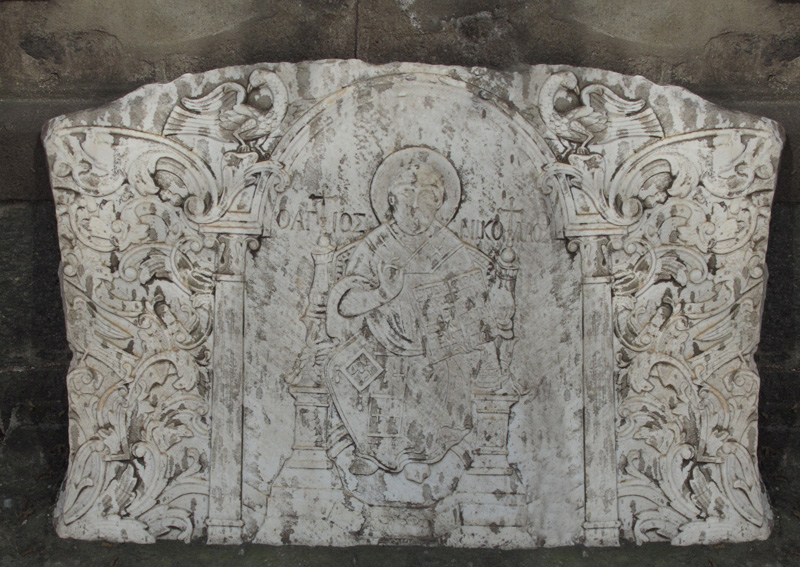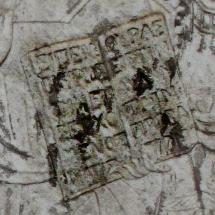The marble icon of St. Nicholas in the yard of the Dutch chapel, present day Greek Orthodox church of Agia Photini in Smyrna/ Izmir. A surviving spolio from the destroyed Greek Orhtodox Cathedral of Agia Photini
Nikos Petalotis, 2013
The church of Agia Photini, the Orhtodox Cathedral of Smyrna/Izmir was a three naved basilica rebuilt for the last time in 1792. The central nave was dedicated to St. Photini, the Samaritan woman who conversed with Jesus at Jacob’s Well, the north (left) one was dedicated to St. Nicholas bishop of Myra (Demre) known in the western world as St. Nicholas of Bari/Santa Claus and the south one (right) to St. Athanasius Bishop of Alexandria.
George Lambakis in his book “The seven stars of the Revelation’’ (Athens 1909) mentions that sailors and generally sea men arriving and departing from Smyrna prayed to the Saint and thanked him for his assistance in the north nave. Lambakis also mentions that on the lintel of the north door of the church, St. Nicholas was depicted in relief. He was holding a Gospel with the inscription “The Lord said, he that entereth not by the door into the sheepfold” (St. John 10:1) in Greek. This text is used as a Gospel reading in the Paraklisis (Supplications service) to St. Nicholas (Εψπεν ο Κυρι?ζ ο μη εισερχομεν?ζ ϑια τηζ θυραζ ειζ την αυλην των προβϖτων…).
On the south door lintel St. Athanasius was depicted, also in relief. Lambakis considers them as mediocre works of art.
On the south door lintel St. Athanasius was depicted, also in relief. Lambakis considers them as mediocre works of art.
The surviving marble relief is stored at the yard of the Dutch chapel, present day Greek Orthodox church of Agia Photini in Smyrna/ Izmir. The photograph was taken by Andrew Simes in 2009.
The marble relief consists of two arches. In its original form it should have been divided in 3 arches, a central broader and two smaller laterals, a right and a left one. The 2 arches are supported by a slim column topped by a stylized pseudocorinthian capital. On the right (central) part St. Nicholas is depicted as a bishop sitting on an elaborate marble or wooden throne. He wears the vestments of an Orthodox Bishop (Sticharion, Phelonion, Omophorion, Epitrachelion and Epigonation). He sits on a rich pillow, he blesses with his right hand and holds an open gospel with his left. The Omophorion and Epitrachelion are decorated with Greek crosses. The epigonation is decorated with a 6 winged cherub. The vertical parts of the throne are ending to 2 spheres topped by a cross. The facial characteristics of the Saint are according to the Greek Orthodox tradition, short beard and a relatively bald head.
There is an inscription in Greek-Saint Nichoals, HO HAGIOS NIKOLAOS, Ο ΑΓΙΟΣ ΝΙΚΟΛΑΟΣ. The same inscription is mentioned by Lambakis. On the open gospel most of the words in Greek can be read. The inscription is the same with the one mentioned by Lambakis again. Both inscriptions are written with clearly carved capital Greek letters.
The left lateral part is decorated with rich foliage. About 1/3 of the left part is missing. Acanthus leaves and flowers are interweaving to each other. The body and the left wing of a bird are depicted at about the middle level. Between the 2 arches a bird is depicted sitting on a branch. Its head is turned backwards to the left and fills the gap between the two arches. There is an evident horror vacui in the whole decoration of the slab.
The marble slab has elements of the so called Ottoman baroque e.g. western baroque motifs as interpreted by Turk, Greek and Armenian masters of the Ottoman Empire. Most probably it was carved for the new church of Agia Photini in the late 18th century. In 18th century the most important Greek marble carving centres related to Smyrna were Istanbul, the island of Chios, Cappadocia and some islands belonging to Cyclades. Chios was famous for its master marble and wood carvers (sometimes the same persons) who worked in different parts of the Ottoman Empire for Greek Orthodoxes and Roman Catholics alike. Considering the vicinity of Chios to Smyrna, the big population of Smyrniots originating from Chios (Orthodox and Catholic) and the splendid iconostasis of Agia Photini carved during the last decay of 18th century, according to a recent research by a master carver from Chios, there is a high possibility the carver of the slab to be an unknown to us master from Chios. The iconographic characteristics of the Saint and the style of decoration can be dated to the end of the 18th c. and beginning of the 19th c. This date is pointed also by the well curved capital Greek letters of the 2 inscriptions.
The church of St. Nicholas in Smyrna was erected in 1884 in the Cay quarter, on plans of the architect I. Christodoulou. The style of the slab is much earlier than the second half of the 19th c.
The depicted saint, the similarities of the Greek inscriptions on the slab compared with the inscriptions mentioned by G. Lambakis, the style of iconography and decoration, the low relief, the material (marble) of the slab and its present location all suggest that the marble slab in the Dutch chapel is the same with the one mentioned by G. Lambakis.
The church of Agia Photini was burnt in 1922 and demolished in the subsequent years. Today there is no trace of it. Perhaps this is the only original spolio from the Cathedral of Agia Photini, saved during the demolition of the church and stored with respect to the yard of the new Orthodox church of Agia Photini in Smyrna/Izmir. Of course any further information related to the origins of the marble slab and the circumstances leading to its present location would be very valuable.
 |
 |
Special thanks to Giorgos Serafim and Kostas Mihalakopoulos, graphic designers (Enthesis-digital printings in the city of Serres). Without them the reconstruction of the original form of the slab and a clearer view of the inscription would have been impossible for me. Many thanks to my close friend Orestis Bouganis for reading the text and correcting the mistakes.
Bibliography
Lampakis G. The seven stars of the Revelation, Athens 1909, p. 200. (in Greek)
Paraklisis to St. Nicholas http://users.otenet.gr/~mystakid/par_agnik.htm
Alexandra Goulaki – Voutira, George Karadedos. Chios, Lesvos and the church carving at the Aegean 16th-20th c. Methexis ed., 2011. (in Greek)
Christos Solomonidis. The Church of Smyrna, Athens, 1960. (in Greek)
Central Smyrna neighbourhoods pre-1922 and the fire zone. Map by George Poulimenos, 2012 http://www.levantineheritage.com/data10.htm